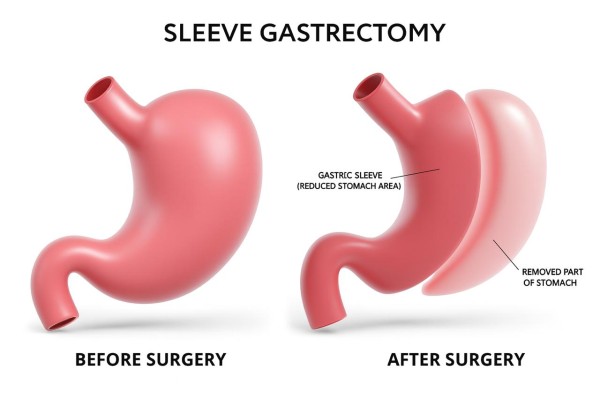Vertical Sleeve Gastrectomy is an effective surgical procedure for weight loss. It involves removing 60-80% of the stomach, leaving behind a small "sleeve" or tube-shaped portion.
This change reduces the amount of food intake, decreases the feeling of hunger, and enhances the sense of fullness quickly, leading to gradual and safe weight loss.
How is the Procedure Performed?
The surgery is performed laparoscopically (using minimally invasive techniques).
About 60 to 80% of the stomach is removed, leaving a narrow tube-shaped stomach.
The intestines are not bypassed or altered, so the absorption of nutrients remains largely unaffected.
Benefits of Sleeve Gastrectomy:
Weight Loss: Patients typically lose 60% to 80% of their excess weight within the first year after surgery—a relatively fast result.
Improvement in Health Conditions:
Type 2 Diabetes
High Blood Pressure
Obstructive Sleep Apnea
Heart Diseases
Polycystic ovary
Bone problems
Early Satiety: The smaller stomach size helps patients feel full more quickly.
Minimal Impact on Nutrient Absorption: Compared to other procedures like gastric bypass, sleeve gastrectomy has less effect on nutrient absorption.
Possible Risks and Complications
Although the surgery is relatively safe, some risks may occur, such as:
Bleeding or infection (as with any surgical procedure).
Leakage from the stapling line in the stomach.
Gastroesophageal reflux in some cases.
Weight regain over the long term.
There are strict medical protocols in place to manage these complications if they occur, making the procedure safe and reassuring for patients.
Who is a Candidate for Sleeve Gastrectomy?
This surgery is recommended for individuals with severe obesity, including:
Patients with Class I or II obesity, especially when associated with obesity-related medical conditions.
Those with a Body Mass Index (BMI) over 30 kg/m² and health problems related to excess weight.
People who have not succeeded in losing weight through traditional methods like diet and exercise.
After the Surgery
The patient starts moving and drinking fluids soon after waking up from anesthesia.
A special pain management device is used before leaving the operating room.
The medical team closely monitors the patient’s vital signs during the first night in the hospital.
Most patients can go home the next day to continue recovery.
A gradual dietary program is followed: (Liquids → Soft Food → Solid Food).
Commitment to regular exercise is essential.
Continuous follow-up with the medical team is necessary to ensure the best results and to avoid complications.
Can the Weight Come Back After Sleeve Gastrectomy?
Yes, weight regain is possible if the patient does not follow medical advice and maintain a healthy lifestyle after surgery.
However, it is important to understand that:
Weight regain is not a failure of the surgery itself, but usually a result of poor dietary habits, lack of physical activity, or other factors such as hormonal changes (e.g., after pregnancy).
Maintaining a balanced diet, engaging in regular exercise, and ongoing follow-up with the healthcare team are key to preserving the results.
In some cases, continuous psychological and nutritional support is provided to help patients adjust to their new lifestyle.
Final Thought
Sleeve gastrectomy is a powerful and safe tool for weight loss and improving quality of life, especially for those suffering from severe obesity or obesity-related chronic diseases.
Excellent results are achievable when patients commit to medical guidelines and adopt a healthy lifestyle after surgery.


